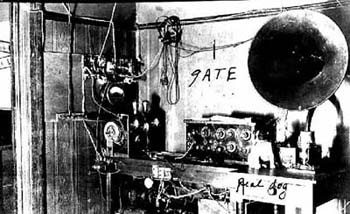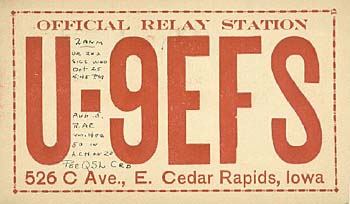|
|
|
|
|
 |
9ATE This April 1924 QSL is from 9ATE at Shickley, Nebraska. That is apparently a real Fox terrier puppy sitting on the operating table immediately to the right of the receiver and below the horn speaker. Note where 9ATE has written "Real dog" on the card and just below the pup. This QSL confirms a contact with 9AHH at Eagle Grove, Iowa. |
|
|
9AHH This young man, 14-year old Raymond H. Williamson, was licensed on September 10, 1921 at Eagle Grove, Iowa. Bill also has his 9AHH license signed by U.S. Radio Inspector L. R. Schmitt, Chicago, IL. Amateur licenses then were issued by the U.S. Department of Commerce. The Secretary of Commerce in 1921, whose name appears on the license, was one Herbert Hoover. The antenna photograph (below) is of what was called a Flat Top. OM Williamson apparently did quite well working DX with this classic antenna, as Bill has QSL cards to him from several countries.
The 9AHH QSL (above left) is rather cluttered, but nevertheless quite interesting. Careful inspection shows the signatures of a number of amateurs. The entire back of the card is likewise autographed. Williamson had this QSL with him at a 1923 "Iowa Radio Convention and Banquet" held on the campus of then Iowa State College in Ames. It was an era when it was popular to collect the autographs of those attending such conventions. See also the 1924 QSL card (left) of Dartmouth College Amateur Radio Association station 1YB (Hanover, NH) that was sent to 9AHH, confirming a contact between the two stations. |
|
|
9CS This dates back to the spark era circa 1923. Spark transmitters were battling new CW (continuous wave) transmitters and would soon lose out to the new technology. D. A. Bailey, 9CS, of Clinton, Iowa was a "spark forever" diehard, as his QSL stated. The faded photograph of the 9CS spark transmitter was taken in early 1922. Careful inspection reveals a high voltage caution emblazoned on the upper wall. Paying heed to such warning was highly advisable around spark transmitters.
9YI Also in Iowa, amateur station 9YI directly evolved into broadcast station WOI, licensed to Iowa State College in Ames in the mid 1920s. WOI survives and still belongs to Iowa State University. Amateur station 9YI likewise exists today as amateur station W0YI at ISU. For a "short version of the long history" of WOI, see http://www.woi.org/history/history.html |
|
|
9EJQ This is a fine example of the "modern" 1929 ham station at 9EJQ in Goldfield, IA. Most, if not all, of the equipment is home built, and obviously made with great pride by R. P. Griffith. The photo was taken December 7, 1929. The close up photograph (below) is the 9EJQ transmitter seen in the other photo, but with the cover removed. This transmitter's power supply featured a pair of the then-new VX281 rectifiers which helped to vastly improve the tonal quality of the transmitted CW signal. These two photographs were taken by Griffith using available "electric lights" and a handheld Kodak camera, according to notes written on the back of a photograph. The 9EJQ QSL is from November 1928 for a contact using a transmitter built before the one in the photographs.
|
 |
9EFS This is a 1925 QSL from amateur 9EFS in Cedar Rapids, Iowa using the self-assigned "U" prefix. It wasn't until 1928 that the U.S. Department of Commerce, as the United States licensing authority, began using the W and K prefixes for amateur stations. In 1927 in Washington, DC there was an International Radiotelegraph Convention wherein prefixes were decided. The U.S. had assigned to it the prefix letters W and K, the W for all amateur stations within the continental US and the K for US insular possessions and Alaska. The Department of Commerce began issuing W and K ham licenses on October 1, 1928 and at the same time instructed all U.S. amateurs to follow suit. That did not happen immediately, as oldtimers are sometimes slow to change. Up until the gradual switchover was completed in 1930, American stations working DX self-assigned themselves the "U" so stations hearing them would know they were in the United States. Some Americans went so far as to use "NU," which signified North America-United States. Canadians used "C" (which caused some confusion with Cuba). |